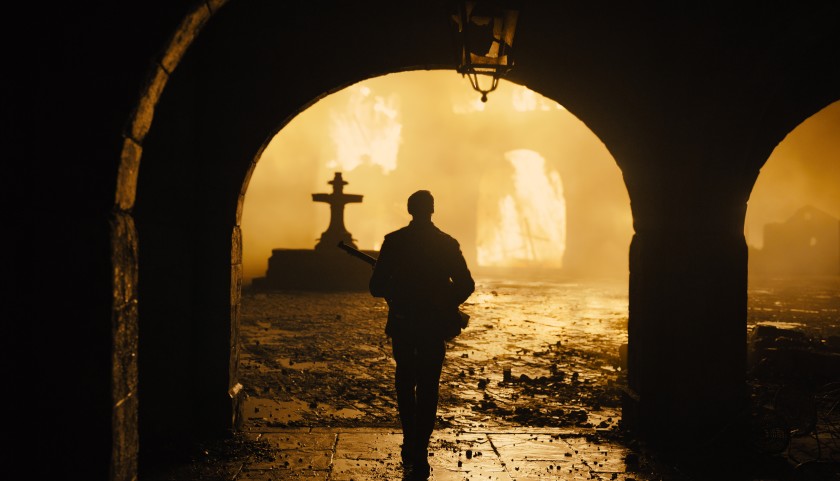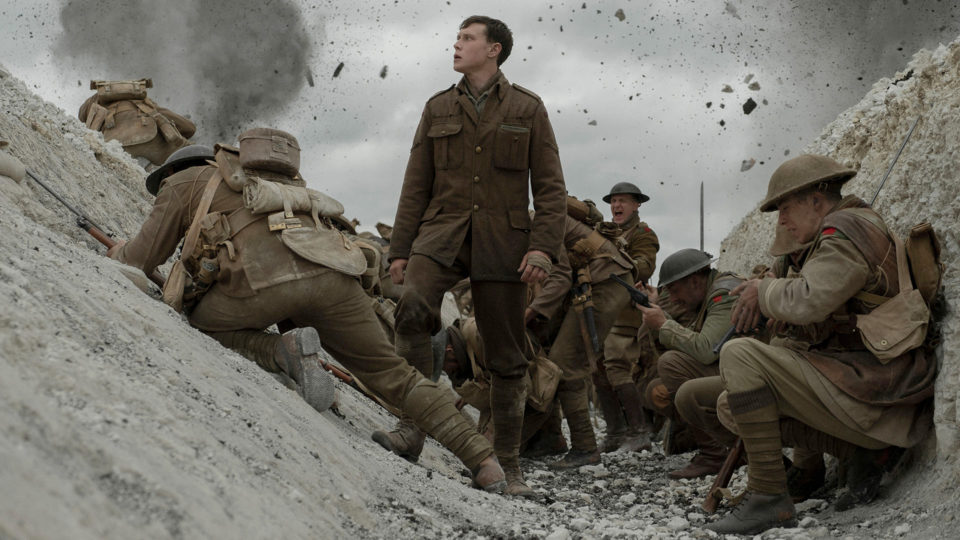English director Sam Mendes’ latest production, 1917, is a World War One action film that tells the tale of two young British men as they attempt to save their fellow soldiers from walking into a German trap. To do this, the two soldiers must bring a handwritten letter from their commander across northern France to the British frontline. Along the way they encounter physical and emotional obstacles that attempt to impede them from completing their mission in time. 1917 has a rather formulaic plot with a surprising amount of nuance between its bare bones. Still, the film ultimately comes out with a near-masterpiece level of quality thanks to how the more subtle moments and exuberant technical aspects accumulate to create a spectacular whole.

The opening of the film: the two soldiers get assigned their difficult task.
The story of 1917 should feel familiar to most people who have seen a lot of war films. The common character and plot tropes are almost all present. Like most war movies of the past, 1917’s structure is concerned with hopping from one action set piece to the next. Luckily, in this film, all of these set pieces are visually breathtaking. Each scene remarkably ends up being more chaotic and intense than the prior.
1917 even draws a lot of its narrative elements from traditionally structured fantasy adventure films. Specially selected protagonists serve as heroes to bring an item across dangerous terrain to stop the seemingly inevitable destruction of the things that they love. While this intentionally vague plot synopsis could be describing The Lord of the Rings, Pan’s Labyrinth, or even Finding Nemo, it also serves as an equally apt description of 1917. In order to break free from the monotony that can come with these typical “hero’s journey” films, 1917’s writers employed a few unique character combinations.

In one of the action scenes, the protagonists must make it across a river.
The two young soldiers played by Dean-Charles Chapman and George MacKay don’t conform to many of the standards set forth by other films in similar genres. Sure, at first, the character of Lance Corporal Blake (Chapman) can easily be placed in the archetypal category of an optimistic soldier who is not yet used to the horrors of war. However, by the end of the first act, his character arc is adjusted in an unexpected trajectory; making him a far more developed protagonist. On the other hand, Lance Corporal Schofield (MacKay) feels like a completely new type of character. He has more experience as a soldier than Blake and is shown (through some of the action sequences) to be a superior fighter. Yet, his views on the war are full of ambivalence. On more than one occasion he asks existential questions and ponders about his place in the war. MacKay’s performance shows that this is a character in between the stages of being a soft soldier like Blake and one of the hardened boot camp officers seen in films like Kubrick’s Full Metal Jacket. This transitional period of character development is one that is relatively uncharted in recent war films.
The combination of Blake’s recognize-ability and Schofield’s complexity makes for legitimately engrossing dialogue. These are the moments of the film which contain shockingly deep investigations into masculinity, life and death, and religion. These calm and tender scenes of growth act to ensure that the framework of the film isn’t torn apart by the copious amounts of kinetic energy radiated by the high-octane combat scenes. In fact, the pacing of 1917 never seems to hurry or falter too much. Often times, when the protagonists in a film are rushed on a journey, it is a difficult task to make sure that the plot lines don’t also feel rushed. One particular scene late in 1917, which takes place in a French basement, is an exemplar example of how the slower moments balance out the film while still feeling tense enough to not lose the film’s forward momentum. It also happens to be one of the best scenes to show off George MacKay’s complex performance.
The aspects of 1917 that have (rightfully) been getting the most attention are the technical feats that the production crew achieved. Specifically, the cinematography has commonly been heralded as some of the year’s best. With the legendary Roger Deakins behind the camera, Sam Mendes set out to make the film look like one continuous shot. The cuts of the film are stealthily masked by camera movement, lighting changes, and objects that fill the frame of the screen.

The trenches of the film make perfect pathways for the camera to track through smoothly.
This method of film-making has been done several times before. Perhaps the most notable example is Alejandro G. Iñárritu’s 2014 film Birdman or (The Unexpected Virtue of Ignorance). Some critics condemn this type of film because they feel the one-shot style is often only done as a gimmick, and in many situations this could be true, however, in 1917 the one-shot style seems to have significant narrative purpose. In most films, cuts and transitions momentarily allow the audience to relax. 1917’s lack of noticeable cuts implies its refusal to let its audience breathe comfortably. This also means that the tension never gets time to trickle away. Just like the soldiers of the film, the audience feels as if there could be danger around every corner, and so when the danger finally appears, it feels earned.
Even with the laborious tasks that come with creating a one-shot film, the camera in 1917 still paints the characters and their environment in an awe-inspiring light. The camera movements are smooth as the shots fly through trenches and dolly across the expanse of the film’s version of no man’s land. The shot composition captures every angle of battle and the dynamics of every character relationship. The color palette is often heavily saturated to juxtapose the bleakness of the war.

In one of the battles, a city is lit ablaze
The sound design of the film is also impeccable. Every gunshot and explosion rings out with a cacophonous sound. The work done with theses effects allow the audience to feel the impact of the bullets even when they aren’t seen. The combination of the visual and aural stimulation that comes with 1917 makes the film a tremendously immersive experience.
On the surface, 1917 may seem like a stereotypical war movie with a flashy visual style. However, there’s an incredibly deep story with likable characters and sub-textual themes to found within this must-see film.
1917 was nominated for eight Oscars at this years Academy Awards and won three: Best Visual Effects, Best Cinematography, and Best Sound Mixing.
![]()

